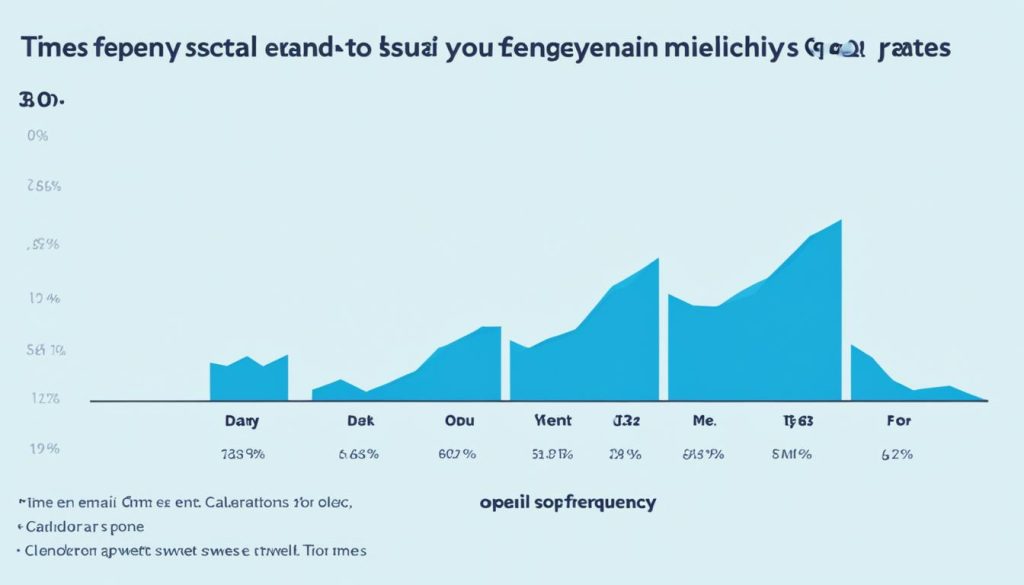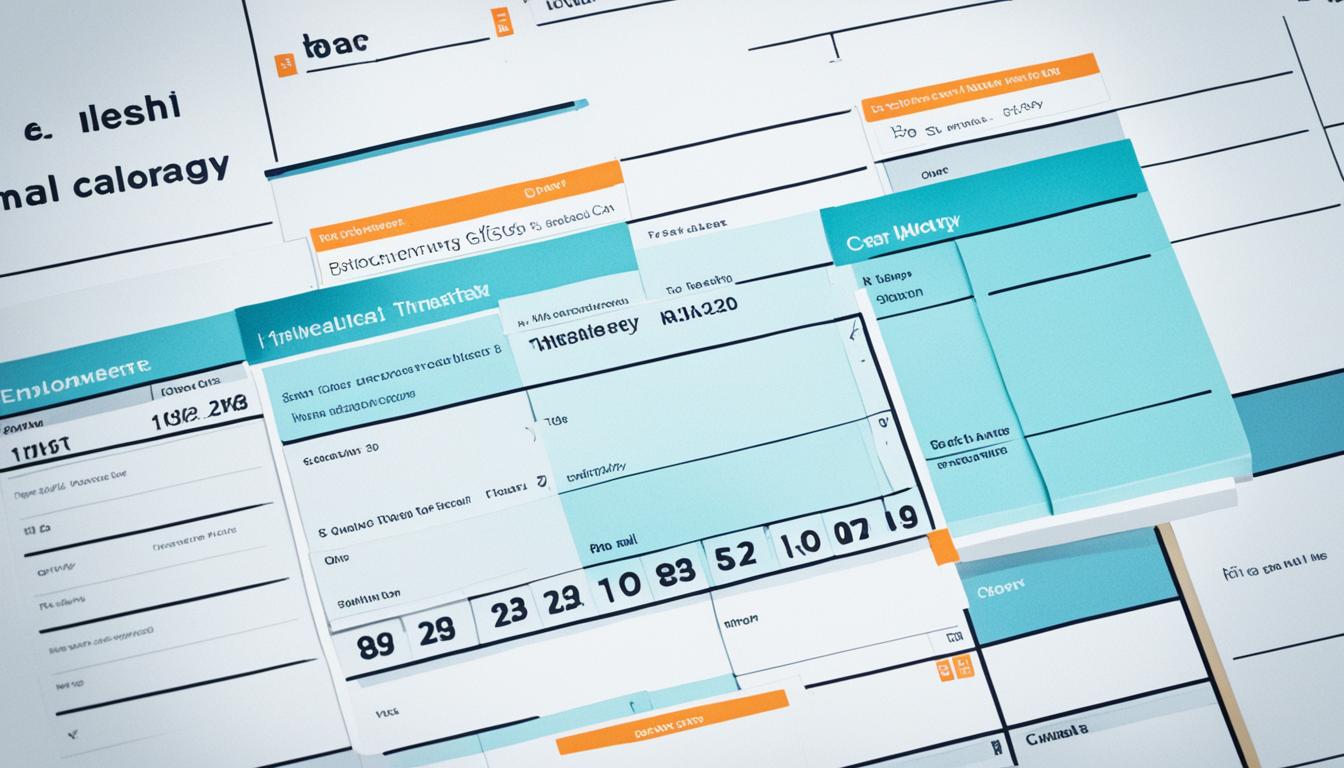For many digital product creators, ConvertKit has been a true game changer. It helps with selling eBooks and digital products smoother. We’ve actually made more from our digital products than ads and affiliate marketing combined. This shows how valuable a strong email list can be for earning passively.
Figuring out the ideal email frequency for your subscribers is key. It ensures you’re engaging them without overdoing it. This guide will look at ways to figure out the best cadence for your email list. We’ll help you keep your subscribers happy and loyal without flooding their inboxes.
Ever thought about What is the optimal email frequency for your subscribers? The answer might not be what you think. We’ll talk about data-backed tips that can make a big difference. Let’s jump in and uncover how to find the sweet spot. It will help you strike that perfect balance and keep your audience interested.
The Importance of Email Frequency for Subscribers
Sending great emails is not enough. The timing is crucial. The timing affects not just Email Deliverability, but also your Subscriber Engagement and the value of your Email List Management. It’s all about finding the right balance with your emails.
Why Email Frequency Matters
Digital marketing is tricky. Even the best emails see less response over time. If you send too many, people might ignore them or leave. Send too few, and you risk losing touch. It’s all about getting that perfect rhythm to keep people interested but not annoyed.
Subscriber Engagement and Revenue
The number of emails you send affects how involved your audience is and your earnings. Get the timing right, and you’ll turn readers into fans and then into customers. That’s why managing your email list well is key to building a loyal and growing base.
Finding the Right Email Cadence
Finding the best email cadence for your audience is key. You want to keep them interested without spamming their inbox. Using insights from studies and benchmarks can help strike the perfect balance.
Industry Benchmarks and Studies
Studies suggest that sending emails two to three times per week works best. Sending once a week is good too. But if you go up to four or five times, people might lose interest. It’s all about figuring out the email frequency that works for your audience, getting you more opens, clicks, and sales.
Testing and Optimizing Your Send Cadence
Testing different email send frequencies tailored to your audience is crucial. by tweaking your email marketing automation plan. Try various schedules and keep an eye on how people interact with your emails. This includes looking at open and click rates, as well as who’s unsubscribing. It will show you the best frequency to keep people engaged without bothering them too much.
| Email Frequency | Open Rate | Click-Through Rate | Unsubscribe Rate |
|---|---|---|---|
| Once per week | 22% | 2.1% | 0.5% |
| Two to three times per week | 25% | 2.4% | 0.3% |
| Four to five times per week | 21% | 1.8% | 0.7% |
The data in the table shows how critical it is to strike the right balance with your email cadence. By playing with how often you send emails, you can keep your audience happy and active. This leads to better results overall for your email marketing automation strategy.
Let Your Subscribers Decide
It’s smarter to let subscribers choose their email content and frequency. Give them the power through an Email Preference Center. This way, they only get what they’re interested in. It reduces spam complaints and helps you build a good sender reputation.
Preference Center for Email Frequency
Everyone likes different amounts of email, so letting them choose is crucial. It keeps people interested and boosts your Email List Management. Also, your Subscriber Retention will improve.
When subscribers control what they get, you connect better and find more sales chances. It shows you value their time and what they want, which helps strengthen your relationship. This trust is essential for your email list’s health.
Goals and Occasions for Increased Frequency
When focusing on your email marketing automation plan, consistency in sending emails is key. But sometimes, you should up your game to keep people engaged and well-informed.
During big changes or if there’s a limited-time offer, sending more emails can be wise. It helps in sharing important news. However, you must find a balance. You want to keep folks in the loop without bombarding them.
Checking on how subscribers react to your emails is crucial. This way, you’ll know when to send more. It’s all about keeping that vital link strong. At the same time, you avoid overloading them to maintain their trust.

Measuring Email List Frequency Impact
It’s vital to find the right Email Frequency for Subscribers to keep them engaged. This helps in maintaining a good Email List Management plan. The key is to watch how often people interact with your emails and how many unsubscribe.
Tracking Subscriber Engagement Metrics
Do your subscribers keep liking and trusting your brand? Look at who opens and clicks your emails. The time between sending emails is just as important as what’s inside them. Use what you learn from this to tweak when and how often you send emails. This can boost how much your subscribers get involved with your emails.
Monitoring Unsubscribe Rates
Seeing more people unsubscribe means you might be emailing them too much. In fact, 73% say they unsubscribe because of too many emails. If you see more people leaving, it’s time to change your email strategy. Make sure to check Unsubscribe Rates often.
Keep an eye on how people engage and if they leave. This lets you get your Email Frequency for Subscribers just right. You’ll send emails at a rate that keeps your audience interested.
Email Frequency for Subscribers
Knowing how often to send emails is key to successful marketing. Finding the right email frequency for subscribers helps your content reach more people. Plus, it builds a stronger bond with your audience.
But beware, sending too many emails can push people to unsubscribe. The trick is to get the right rhythm for keeping subscribers engaged. This leads to more opens, clicks, and ultimately, more sales.
To do this, look at what others in your industry are doing. Test out various sending frequencies. And always keep an eye on your email list management stats to see what works best.
When you find the sweet spot, your email marketing becomes a powerful tool. You’ll grow a loyal fan base that eagerly awaits your emails. Getting the right email frequency is essential for a thriving email list.
The Cost of Sending Too Many Emails
It’s key to keep in touch with email subscribers. But, if you send too many emails, it can backfire. People might unsubscribe or mark you as spam. This can make it harder for your emails to get through.
Unsubscribe Rates and Spam Complaints
What’s the top way companies could be better at email marketing? According to a survey, it’s sending less email. If you fill up your subscribers’ inboxes, they might get tired of it. This could lead them to unsubscribe.
Too many emails might also lead to spam complaints. If people think you’re overloading them, they could mark you as spam. This hurts your ability to email everyone on your list.
Sender Reputation and Deliverability
Your sender reputation matters a lot. If people are often unsubscribing or marking you as spam, email services notice. They might then think your messages are not wanted. This could mean they don’t deliver your emails as often.
Keeping your email list healthy and finding the right email frequency is crucial. It helps keep your sender reputation good, letting your messages through. This way, you can build a good connection with your audience and make your email marketing more effective.

Factors Influencing Optimal Email Frequency
Finding the right Email Frequency for Subscribers means looking at key points. You need to consider their Business Model (B2B vs B2C), what their audience likes, and your goals. For instance, what are you trying to achieve, more awareness or more sales?
Business Model (B2B vs B2C)
B2B and B2C users act and react to emails differently. B2B clients like getting informative emails at a slower rate. On the flip side, B2C customers might enjoy more visually appealing, frequent emails. It’s essential to know your client’s model to pick the best emailing frequency for them.
Customer Expectations and Preferences
It’s key to know what your audience wants in email frequency. Use surveys, check how they engage, and listen to their feedback. This helps fathom if they prefer more or less emails. Matching your sending rate to what they like can really increase how they interact with your emails.
Marketing Goals (Awareness vs Conversions)
What you want from your emails affects how often you should send them. If just making people aware of your brand is your aim, a regular, informative email flow might work best. However, for pushing sales, sending more focused, promotional emails could be the way. Make sure your email frequency lines up with your main marketing goals to get the best results.
Taking all these factors into account can help you settle on the best Email Frequency for Subscribers. This will keep your subscribers interested and ready to hear more from you.
Best Days and Times for Sending Emails
Maximizing your email Email Frequency for Subscribers is key. The timing of when you send your emails really matters. Insights from research show the best days and times to send emails for Subscriber Engagement.
Weekday vs Weekend Performance
Weekdays are more popular for emails than weekends. Mondays stand out, with a 22% open rate. Tuesdays have the most clicks at 2.4%. But, weekends see the lowest activity with a 20% open rate. Thus, it’s better to focus your Email Marketing Automation during week days for better Subscriber Engagement.
Optimal Send Times by Time Zone
Noon is the best time to email people. They have a break and can check their email. It’s crucial to also think about time zones. Make sure your emails arrive when it’s convenient for your readers. This custom approach pairs your Email Frequency for Subscribers with their schedule. Hence, boosting your Email Marketing Automation results.

Giving Subscribers Control
In email marketing, we must respect our subscribers’ space. Instead of sending emails they don’t want, let them choose. Our Email Preference Center lets subscribers pick what emails they get. This keeps our audience interested and attracts the most captive ones, helping with Subscriber Retention.
Email Preference Center
Letting subscribers decide how often and what they receive is good for everyone. They get emails that fit their needs, and we learn more about them. This approach lowers the chance they’ll leave, keeping our list engaged.
Exit Survey for Unsubscribes
Even with a great Email Preference Center, some might still leave. Adding a quick survey can help us understand why. This feedback is crucial for us to make better email campaigns and meet our audience’s needs.
Segmenting Your Email List
Not all emails should be the same. Your subscribers have different likes and interests. To make your emails work better, divide your list into groups. This helps you send the right content at the right time to the right people.
Engagement-Based Segmentation
Start by sorting your subscribers by how much they interact with your emails. Know the active ones from the others. Those who always open and click are “primary.” Those who do sometimes are “secondary.” Lastly, those who aren’t very active are “dormant.” Sending personalized emails to each group can boost your email list segmentation, subscriber engagement, and email list management.
Demographics and Firmographics
Another way to group your subscribers is by who they are and where they work. Consider things like their age, gender, job, or company. Knowing about them helps you send messages that really speak to each group. For example, you can share special product offers or invites to events that fit their interests.
Purchase History and Website Behavior
Look at what your subscribers buy and do on your website. You can group them based on what they buy, how much they spend, or what they look at online. This helps you see who your biggest fans are, remind about their abandoned carts, or suggest other items they might like. Using data on subscriber behavior improves your email list segmentation, subscriber engagement, and email list management.
Understanding Your Target Audience
Before you decide on the right email Email Frequency for Subscribers, you need to know what your target audience wants. No matter if you sell to other businesses (B2B) or consumers (B2C), their behavior and what engages them can be quite different.
B2B vs B2C User Behavior
If your business serves other businesses with a Business Model, they likely want professional, useful content. They might not want emails very often, since they’re busy with work. However, consumers in B2C might enjoy getting emails more often. This way, they can learn about things that interest them.
Competitor Analysis
Looking at how your rivals talk to their customers can help a lot. It can give you ideas on how to do better. By checking their emails’ frequency, topics, and how engaged their subscribers are, you can find what works. This can help you stand out in your market.
Industry Benchmarks and Surveys
Find out what’s typical in your field for email marketing’s main results, like email opens and clicks, and how many people stop getting emails. Also, you might want to do your own surveys. Talking to your audience directly can tell you what they really like. This info can guide you in setting the right tone and amount of emails you send.
Aligning Email Cadence with the Customer Journey
Creating a great email marketing plan means adjusting how often we send emails to match where customers are in their journey. At the start, in the Reach stage, we make our brand known. We do this by sending emails less often, about once a week. This helps our audience get to know what we offer.
When subscribers move to the Nurture stage, we up our email game to two or three times a week. At this point, we aim to focus on those who are most interested. We want to provide them with content that helps them learn more and make informed choices. This includes helpful info, learning materials, and updates on our products. Doing this keeps our subscribers interested and leads them closer to making a purchase.
Sticking to a regular schedule for sending emails is key for keeping our audience interested and boosting sales. We should always watch how users interact with our emails, check which content they like, and adjust our email timings when necessary. By being smart about how often we email and matching it to where our customers are in their journey, we make sure they get the right emails at the right times. This will make our email marketing efforts more successful in the end.

